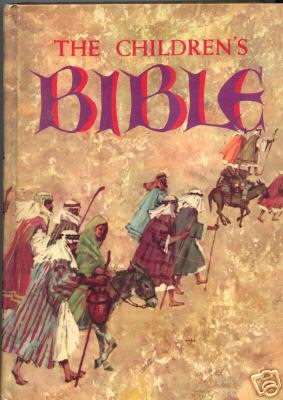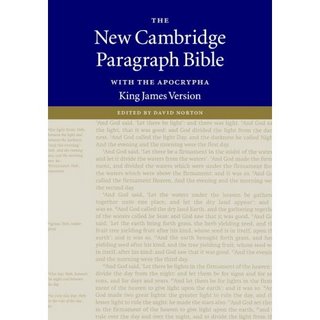 The last time I visited my mother's house in Tennessee, I spent a number of hours hunting thru bookshelves, boxes, and drawers for one of the great books of my childhood, a vividly illustrated "Children's Bible." I couldn't find the book, but I paged thru a copy in a used bookstore yesterday, & recognized every single one of the paintings I laid eyes on: the blinded Samson pushing apart the pillars of the Philistine temple; the prophet Daniel being hauled out before, & refusing to worship, Nebuchadnezzar's golden image; the rebel Absalom with his Robert Plant-like locks tangled in a tree branch, awaiting the death blow.
The last time I visited my mother's house in Tennessee, I spent a number of hours hunting thru bookshelves, boxes, and drawers for one of the great books of my childhood, a vividly illustrated "Children's Bible." I couldn't find the book, but I paged thru a copy in a used bookstore yesterday, & recognized every single one of the paintings I laid eyes on: the blinded Samson pushing apart the pillars of the Philistine temple; the prophet Daniel being hauled out before, & refusing to worship, Nebuchadnezzar's golden image; the rebel Absalom with his Robert Plant-like locks tangled in a tree branch, awaiting the death blow.I do have in my study, however, a slightly later acquisition: a lavishly annotated & appendicized King James Version published by the John A. Dickson company of Chicago in the sort of leather binding that must be laid flat (on a coffee table, presumably) rather than shelved, presented to me by my parents in January 1975. I never thought I'd ever buy another "presentation" Bible – after all, I've entered all the family genealogical data into this one, & there are a number of other KJVs kicking around the house & the office (the Oxford World's Classics, which I've been teaching out of, a little portable thing in black binding, and an odd "original spelling" edition the Thomas Nelson people put out some years back), not to mention the various others – the New English, an NIV, Everett Fox's Five Books of Moses, various volumes of the Anchor Bible...
 But today Amazon delivered up the presentation copy of David Norton's New Cambridge Paragraph Bible (CUP, 2005). Did I want another huge book that can't really be shelved? Not really, but the regular CUP hardcover seems to be already out of print, & at least this comes in a cardboard slipcover that stands it upright. What's most revelatory, however, is Norton's approach to editing this volume. He's not a theologian or Biblical scholar per se, but a textual critic, & his goal is not to somehow get the KJV closer to the Hebrew & Greek (& Aramaic) texts of the Bible, but to get this KJV closer to what the original translators of 1611 intended.
But today Amazon delivered up the presentation copy of David Norton's New Cambridge Paragraph Bible (CUP, 2005). Did I want another huge book that can't really be shelved? Not really, but the regular CUP hardcover seems to be already out of print, & at least this comes in a cardboard slipcover that stands it upright. What's most revelatory, however, is Norton's approach to editing this volume. He's not a theologian or Biblical scholar per se, but a textual critic, & his goal is not to somehow get the KJV closer to the Hebrew & Greek (& Aramaic) texts of the Bible, but to get this KJV closer to what the original translators of 1611 intended.Most folks who use the KJV aren't aware that the vast majority of King James Bibles out there reproduce the text, not of the 1611 Authorized Version, but of a 1769 revision thereof. In short, the editors & publishers of the AV saw fit to tinker with the text – changing punctuation, wording, spelling – for about 150 years before they decided to settle down and stick with a single version. So the KJV one encounters today is essentially a mid 18th-century version of the 1611 text, with mid 18-th c. spellings & punctuation.
Norton has gone back to the first edition & beyond that to the translators' notes & manuscripts. For the most part, he's returned to 1611 punctuation, which he feels is actually closer to contemporary usage than the 1769 punctuation. At a number of textual cruxes, he's found the KJV translators more convincing than their revisors: when Paul, in 1 Timothy 2.9, urges "that women adorn themselves in modest apparel, with shamefacedness and sobriety" (this is the received AV), Norton points out that the 1611 translators wrote in "shamefastness and sobriety." To be "shamefaced" is to be ashamed; so might "shamefast," but it's more compellingly read as "holding fast to modesty."*
At the same time, this is a modernized text, in the same way that almost all texts of Shakespeare we read are modernized: spelling, especially, has been brought up to date, & some of the more vexing verb tenses have been sorted out (you have no idea how much agony the verb "bear" – as in childbearing, KJV past tense "bare" – routinely causes my students). Weird archaisms have been replaced with clearer cognates: the Philistines in 1 Samuel 5 don't have "emerods" any more, but more prosaic "haemorrhoids." Norton has inserted quotation marks for speeches, & heaven knows how many troubles that'll clear up.
But what's most compelling about this KJV are not the tinkering with text & orthography but the formatting. As its title indicates, it's a "paragraph" Bible, which means that instead of the maddening World's Classics format (each verse a separate paragraph, double columns), this Bible has broad single text columns, divided into real live paragraphs (with verse divisions indicated by teeny superscript numbers). It's this particular innovation (not really new, since the first Cambridge Paragraph Bible came out in 1873 or so) that makes this the most readable KJV on the block.
Of course, I'm not assigning this monster to my Bible as Lit students this fall, & I'm not recommending anyone out there buy this presentation volume, either (for heaven's sake, it doesn't even have a family register!); turns out that the David Norton Cambridge text will be the basis for the forthcoming Penguin Classics Bible, due out in three weeks or so.
*No connection to recent discussion of mammary exposure in 17th-c. portraiture.
1 comment:
Thanks to your note last night I correctly identified the word "emerod" on page 70 ish of Catherine Daly's enormous and mindbending "To Delite and Instruct". Honestly, then three come along at once... !
Post a Comment